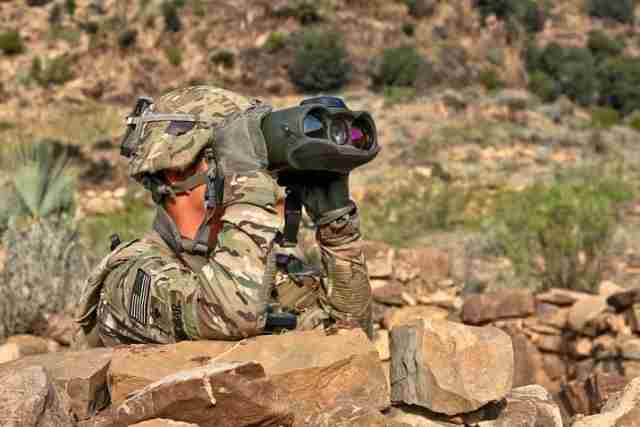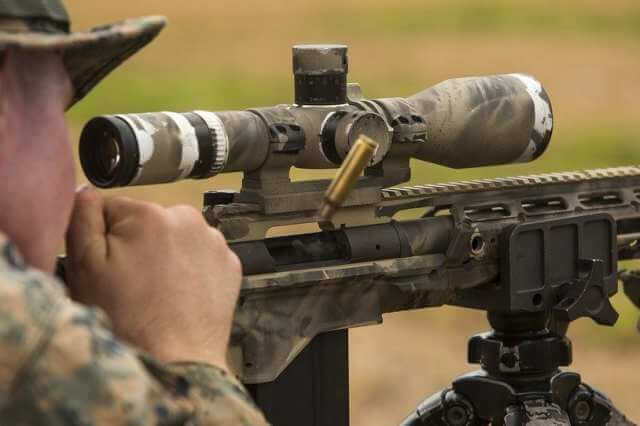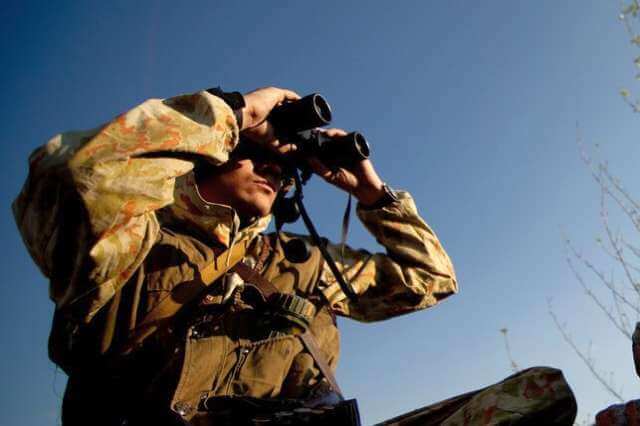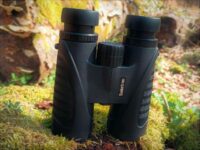Binoculars for military use must meet special requirements. At first, you might think of camouflage, but much more important are robustness, durability, and performance in all imaginable situations and environments from the desert to the Arctic and of course the optical qualities.
Many different kinds of binoculars are used by the Military, and each type serves a different purpose. The army uses binoculars for reconnaissance, training, surveillance, combat, and much more. In this article below, we take a closer look at all of the different types of binoculars that are used by the Military and discuss the different specifications and differentiating factors of each one.
What Binoculars Does The Army Use?
Military personnel uses different types of optics from handheld binos to sophisticated instruments that meet very specific requirements for special missions. To a regular person, a pair of binoculars might seem to just be a simple device or tool, but when it comes to military specifications, their binoculars have properties such as high-quality glass, multi-coated optics, rangefinders, laser protection, and mil dots, just to name a few.
US Army and Marine Corps have used M22 Binoculars with 7x magnification and 50mm objective lens for many years. More compact follow-up models used by the Army are the M24 binoculars for lightweight and size or the M25 binoculars with built-in image stabilization technology. The army gets these models from the supplier Northrop Grumman, unfortunately for the normal public, they are not so easy to obtain. Binoculars from German maker Steiner are also popular with military forces around the globe.
No products found.
Why Does The Military Use Military Binoculars?
Tactical binoculars are an essential piece of equipment for the military and are used for all kinds of missions.
Surveillance
Surveillance is an important aspect of military operations, as it allows soldiers to continuously monitor their targets and conduct immediate assessments of the threats or escalations that may occur during a period of time, especially with unconventional enemies such as terrorists.
Hunting
Hunting can be considered a recreational aspect of a serviceman’s life in the military wherever he or she is stationed in, however, when it comes to extended operations – hunting may be a key aspect of the day in order to find food to sustain the serviceman during the operation. Binoculars allow him or her to scout for food from far away, ensuring that the hunt is successful.
Reconnaissance
Reconnaissance is an act of surveillance that is done before the entire operation commences, with the sole intention of gathering as much intelligence as possible before planning an operation that will succeed. Because of its preliminary nature, reconnaissance is usually done in stealth and requires high-spec binoculars that include features such as night vision and optical rangefinders.
Combat
When it comes to conflict, the ability to observe your opponent is the first step to defuse the situation or to turn it to your advantage. During combat, binoculars are used to gauge the entire enemy territory to detect an attack early and successfully avert it. This allows for a much clearer appreciation of the situation and may well be the only thing standing between success and failure.
Different Types Of Binoculars That Are Used In The Military
The type of binoculars that the military use is sometimes referred to as tactical binoculars, and they are generally built to withstand any kind of weather condition and are rugged enough to take a lot of damage while they are used.
Let’s take a closer look at 3 of the most commonly used binocular types by military personnel all over the world.

Rangefinders
When it comes to military equipment, the rangefinder is practically an indispensable part of the arsenal of any armed forces or their respective special units. Rangefinders provide dead-on precise distance measurements, which are critical in operations where accuracy is of utmost priority.
The most common kind of rangefinder you’ll see the military use are laser rangefinders – they have become the standard thanks to their swiss standard precision, lightweight and robust build, making it one of the best tools to have equipped during an operation.
Laser rangefinders work by emitting electromagnetic pulses that can travel incredibly far distances. This laser beam is then reflected off the surface of the target it is aimed at, and this distance and time taken to travel by the laser is then calculated by the rangefinder in real-time, giving the user an accurate distance measurement of the target in sight.

Scopes
Scopes are optics that magnify your targets with the help of glass optics – allowing you to shoot at a target that is much further than the naked eye can gauge precisely. They are usually found mounted on top of rifles, and with all things considered – are one of the most effective upgrades that can be done to a rifle, military or civilian alike.
Inside the scope is a crosshair, which gives the user an aiming point to determine where to center their target to confirm a hit when they pull the trigger. Some of the scopes found in military use are below.
Fixed scopes give the user a fixed magnification level that allows them to shoot from a considerable distance away from the target. However, because the magnification is fixed, there is no zooming in or out on a fixed scope – what you see in the scope is what you get.
Variable scopes are the swiss army knife of rifle scopes. They allow the user to adjust the magnification in the scope to a level that fits the current target distance and situation. For this reason alone, they are usually the most expensive choice.
Hunting scopes are scopes that are built with ruggedness in mind, in order to withstand the elements and all kinds of weather – which is generally the kind of situation hunters would find themselves in when they’re spending their time out in the wild.
Competition scopes are, as the name suggests, used mainly in shooting competitions. They are not as durable as hunting scopes or sniper scopes, as they are usually fragile and not meant to be used in situations that are not controlled environments (such as competitions). However, they are very high in magnification and can allow the user to shoot long distances easily.
Sniper scopes are scopes that snipers use for their operations. Contrary to popular belief, sniper scopes aren’t all that complicated – most military snipers use a fixed magnification level of 10x when they go out for operations, which is much lower than competition scopes or even variable scopes.
However, a sniper scope normally uses a mil-dot reticle, which gives the shooter all of the information they need when it comes to things like windage, distance, and bullet drop. The adjustments on sniper scopes come in the form of small turrets that give absolutely precise movements in tiny increments, allowing the sniper to be as accurate as humanly possible before they even lay a finger on the trigger.
Handheld Binoculars
Military-grade tactical binoculars are designed to provide excellent image quality, which is one reason why they are a bit pricier than many consumer binoculars. They are built to give the user the clearest picture while handheld, although high-powered models are generally best used with a tripod or stabilizer when used at max magnification levels.
Military handheld binoculars are made with the best optical glass and advanced coatings that and have the ability to withstand and repel moisture which can cause condensation inside cheap binoculars, rendering them inaccurate and unsuitable for military operations. Marine binoculars are built with waterproofing in mind, as they are used in situations where they are constantly in contact with water.
The three most commonly used handheld binocular models in the military are the M22, M24, and M25 binoculars. The M22 model has a magnification level of 7x, and has a lens diameter of 50mm making it a great all-rounder pair of binoculars for most uses on and off the battlefield.
One of the biggest drawbacks of the M22 however, is the fact that it weighs 2.7lbs, which can add on quite a bit of weight to a soldier’s kit while out in the field. The M24 and M25 are upgraded, yet lighter versions that offer features such as stabilization and portability, which are always handy when a soldier is constantly on the move.
Military Vs. Civilian Binoculars
When we talk about military-grade binoculars, we normally tend to focus on the specifications of the binoculars, and how they are designed to suit the needs of the soldier on the field. Let’s look at some of the most important specs to consider when choosing military binoculars.
Laser Protection Filters
One important difference between consumer binoculars and most modern military binoculars are laser protection filters. This special type of filter is built into the optics and protects the human eye from laser beams that are emitted from laser rangefinders or other target devices. The filter is simply a special glass plate coated with certain metal oxides to become impenetrable for laser radiation.
Field Of View
This specification refers to the picture width that you can see through the lenses of the binoculars, and how much of the area you can see. The general rule is that the higher your magnification level, the smaller your field of view becomes, and high-end military binoculars, are designed to fit a perfect balance between both factors.
Magnification
Magnification is what binoculars are all about. The common binoculars used by the army usually have an 8x magnification and a 30 mm objective lens. Binos with these specs are absolutely sufficient for observation and surveillance during daylight and allow the binoculars to be kept relatively small, compact and lightweight.
In addition to the smaller, compact 8 × 30 models, 7 × 50 or 10 × 50 are also used. 7 × 50 devices have a particularly wide field of view and are therefore ideally suited to explore wide-open areas. They are also the standard binocular sizes used by mariners at sea.
Aperture
The size of the aperture determines the amount of light that enters the binoculars, and thus the brightness and contrast of the images viewed. That is the twilight performance. By applying high-quality, sophisticated coatings to the glass surfaces, the light transmission and thus the brightness and contrast of the images viewed can be further increased.
Reticle
Binoculars with a reticle, also called a graticule, are binoculars that have a pattern of fine lines or markings built into the eyepiece.
The simplest type of reticle is the crosshair, which consists of two lines arranged like an XY diagram, the shape of a cross “+” which you know from a telescopic sight.
In addition, there are many variations of a reticle pattern depending on the application. These allow for calculating heights or distances. Marine binoculars and Army binoculars in particular have a reticle as standard.
Unlike as with binoculars with a range finder, the distance is calculated by the observer, one does not have to rely on technology that can fail.
Night vision
You have to differentiate here, the layman sometimes confuses two different devices.
On the one hand, this term refers to night vision devices that use optoelectronic technology to amplify residual light or convert infrared light into visible light. Night vision devices cannot be used in daylight.
Then there are the low-light binoculars. These are binoculars whose performance is geared towards twilight use so that you can still observe well even in poor light conditions. Unlike night vision devices, these binoculars do not have any complicated technology, but only larger aperture lens diameters (e.g. 7 × 50, 8 × 50, 8 × 56) that capture more light.
Where can I buy Army binoculars?
If you want to buy binoculars that the army uses, you have several options to choose from. Check your local prepper store or army surplus store for used equipment or binoculars. A visit to a specialist shop for optics or hunting equipment will also give you a good selection of army binoculars. And of course, online you can also find almost everything at very affordable prices.
Conclusion
Military binoculars are precision tools built to high specifications and are meant to withstand many years of rugged use out in the field, and in combat zones. This is why they usually come with steep price tags, however, keep in mind that you’ll be paying for quality equipment that has gone through months, if not years of intensive R&D before it is approved for military use.
Most survival or hunting enthusiasts tend to mix up their gear with some military-grade tactical binoculars, because of the high specifications and the robustness of such products. They allow the user to fully maximize their time and experience while out in the outdoors hunting or camping.
Additionally, the military also uses high-tech equipment such as infrared and night vision binoculars, which are used in highly specialized operations. These types can seriously cost a bomb, but to the avid collector, can be a pretty cool addition to their extensive binocular collection.
References
https://www.safran-vectronix.com/laser-rangefinders/
https://warrenknight.com/military-grade-binoculars-other-binocular-types/



